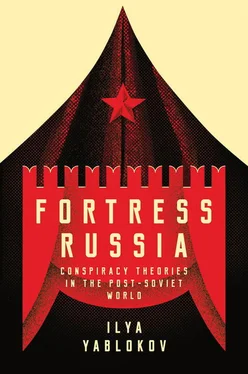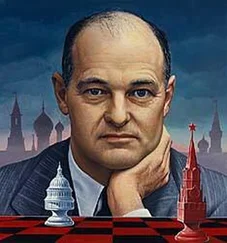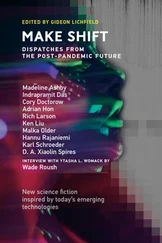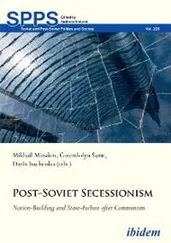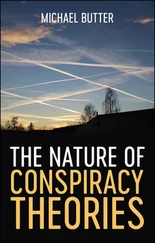By the time the main principles of a sovereign democracy were formulated, Nashi had already organized two events, both of which related to the memory of the Second World War and the Russian resistance to fascism. On 15 May 2005, Nashi organized a demonstration in the centre of Moscow of some sixty thousand young people who, according to the movement’s leader, Vasilii Iakemenko, ‘took up the torch from war veterans [and took it] to the struggle for Russia’s independence’ (Korobov, 2005). These actions, which were extensively covered by the state-aligned television channels, were aimed at creating the impression of a large mass of young people concerned about the country’s future.
Conspiratorial rhetoric was at the centre of Nashi ’s ideology; this was supposedly a community of ‘the people’ who were resisting the West in their struggle to ensure Russia’s survival. In his address to participants of the movement’s first summer camp, held in 2005, Pavlovskii followed the main thrusts of Surkov’s ideology:
European civilization has a different mentality; it always needs an enemy, especially in periods when everything is good. It happened with the Jews at the end of the nineteenth and the beginning of the twentieth centuries. Now it is happening with the Russians. Nowadays, for the West, the Russians are – let us face it – the main outcasts, no matter how good we are. (Kashin, 2005a)
Nashi ’s nation-building rhetoric adopted two main positions. First, it appealed to the memory of the Second World War, which was the most uncontestable and powerful narrative in post-Soviet Russia public consciousness. Second, it emphasized the anti-fascist views of its members, and that Russia’s multi-culturalism was the key to the country’s prosperity. As stated in its manifesto:
The clash of civilizations can kill Russia, as it has already killed the Soviet Union. Our aim is to prevent the expansion of the ideas of fascism, aggressive nationalism, religious intolerance and separatism, which threaten the unity and territorial integrity of Russia. (Manifest, n.d.)
Supporting a multi-cultural Russia served as a positive element in social cohesion and community building. Nashi articulated a civic model of national cohesion: a prosperous Russia could be built if Russian youth shared the idea of racial, religious and cultural solidarity. This could account for the fact that Nashi ’s manifesto contained only the civic term, rossiiskii , and made no reference to the ethnicallyassociated term, russkii .
The intention was to share this ideology of Russian multi-culturalism with the majority of Russian youth who, according to the manifesto’s authors, would replace the ‘defeatist generation of the 1980s’ ( pokolenie porazhentsev ) which had destroyed the Soviet Union. These ‘defeatists’ consisted of so-called oligarchs and radical nationalists (or ‘fascists’) who were both allegedly under the control of the West. These groups were considered to be the main threat to the country’s stability. Nashi defined them as ‘the unnatural union of liberals and fascists, Westernizers and ultranationalists, international funds and international terrorists’, who, despite their differences, were united by their common hatred of Putin (Manifest, n.d.).
Nashi’s call for the current elites to be replaced was supposed to serve as another factor in political cohesion among young Russians. Defining the ruling class as ‘defeatists’ backed by oligarchs and international foundations, Nashi was at the same time attempting to valorize the civic, state-framed model of Russian nation-building and promote it as something worth defending from international conspiracy. Building its ideology based on anti-fascism and the memory of the war, it served to promote patriotic ideas and bind them together with notions about conspiracy.
The nation-building strategies of Nashi were mainly aimed at the development of a civic model of Russian nationhood by attracting potential members by the anti-fascist rhetoric. Still, since it was largely based on conspiratorial notions, Nashi ’s ideology mainly served as a Kremlin’s political tool with which to suppress those opposing the political establishment on the eve of the 2007 parliamentary elections. As Maya Atwal and Edwin Bacon noted (2012, p. 265), Nashi was able to engage in contentious politics which United Russia could not do because of the constraints imposed on the formal political arena. Nashi ’s failure to prevent the opposition rallies in 2011–12 resulted in the decline of the movement, and many of its former leaders then embarked upon political or business careers. However, the Kremlin experimented with other conspiratorial concepts in its attempt to define the Russian nation, and disseminated them through campaigns publicized on the state-aligned television channels. Most of the ideas put forward during these campaigns would be used whenever the regime was challenged by waves of protest, especially after 2012.
‘The Fall of an Empire: The Lesson of Byzantium’
From the beginning of the 1990s, pseudo-historical books explaining how the origins of contemporary events could be traced back to conspiracies in the past became bestsellers (Sheiko and Brown, 2014). As Laruelle (2012, p. 580) notes, the conspiratorial interpretation of the past, which in the post-Soviet period created a large corpus of books on an alternative Russian history, is a powerful promoter of national cohesion. Ideas about the greatness of the Russian imperial order and the malevolent intrigues behind the Soviet collapse created a comfortable intellectual environment for these ideas to become popular. By the late 2000s, pro-Kremlin public intellectuals had realized the value of biased historical accounts in constructing a national identity. Politicians and public intellectuals employed a range of historical ‘facts’ in books and television programmes to convey a political message and turn conspiracy theories into a legitimate element of popular discourse. For instance, Russian minister of culture Vladimir Medinskii has, by means of a series of books on the myths about Russia and anti-Russian plots, made a successful career as a writer and high-profile bureaucrat (Parfitt, 2017).
One of the most obvious cases was the film Gibel’ Imperii: Vizantiiskii urok ( The Fall of an Empire: The Lesson of Byzantium ) which was broadcast on 30 January 2008 on the state television channel Rossiia. The presenter of the film, Archimandrite Tikhon (Shevkunov), was the Superior of Moscow’s Sretensky Monastery, and apparently has close relations with Putin (Korobov, 2008; Clover, 2013). In the film, Tikhon narrates his version of the collapse of the Byzantine Empire. Supported by a dynamic promotional campaign and praised after its screening by the pro-government press, the film produced a heated media debate among Russian intellectuals about parallels between Russian and Byzantine history (Borodina, 2008).
In Tikhon’s view, the collapse of the Byzantine Empire was largely due to the West, whose economic and political interests were represented by Byzantine intellectuals and unfaithful oligarchs. Supposedly the West had stolen from Byzantium in order to create the conditions for its own economic prosperity, which, in turn, helped transform the then-barbarous European states into civilized countries. In the words of Tikhon, one of the greatest Byzantine rulers, Emperor Basyl II,
took tough measures to enforce a vertical power structure, quelled all separatist movements in the outlying territories, and suppressed rebellious governors and oligarchs, who were preparing to dismember the empire. Then he ‘purged’ the government and confiscated huge sums of stolen money. (Archimandrite Tikhon (Shevkunov), 2008)
Читать дальше
Конец ознакомительного отрывка
Купить книгу
